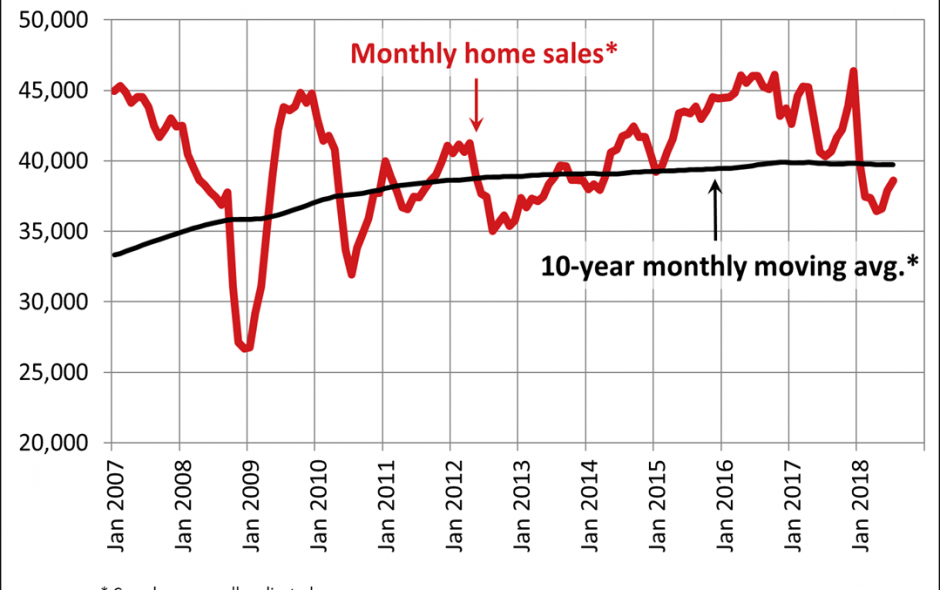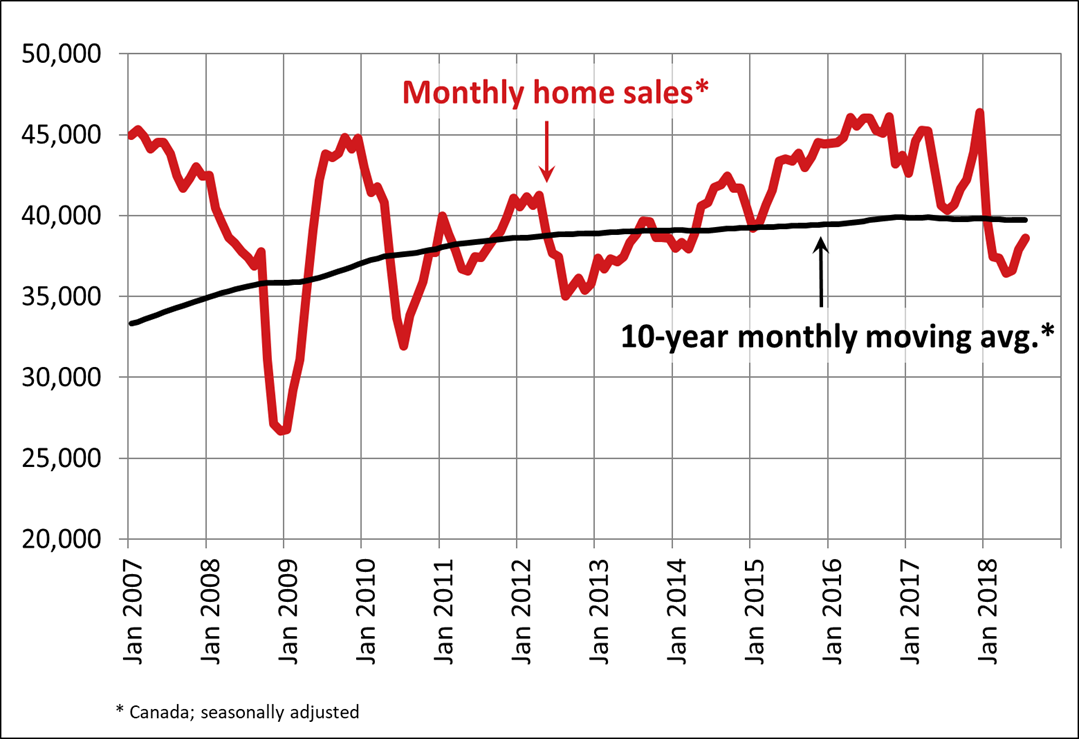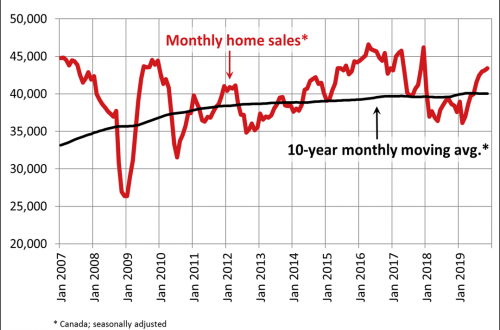Ottawa, ON, September 17, 2018 – Statistics released today by The Canadian Real Estate Association (CREA) show a small increase in national home sales between July and August 2018.
Highlights:
- National home sales rose 0.9% from July to August.
- Actual (not seasonally adjusted) activity was down 3.8% from August 2017.
- The number of newly listed homes was unchanged from July to August.
- The MLS® Home Price Index (HPI) was up 2.5% year-over-year (y-o-y) in August.
- The national average sale price edged up 1% y-o-y in August.
National home sales via Canadian MLS® Systems edged up by 0.9% in August 2018, marking a fourth consecutive monthly gain. However, sales activity is still running below levels in most other months going back to early 2014.
Roughly half of all local markets recorded an increase in sales from July to August, led again by the Greater Toronto Area (GTA), along with gains in Montreal and Edmonton.
Actual (not seasonally adjusted) activity was down 3.8% y-o-y in August, due mainly to declines in major urban centres in British Columbia.
“The new stress-test on mortgage applicants implemented earlier this year continues to weigh on national home sales,” said CREA President Barb Sukkau. “The degree to which the stress-test continues to sideline home buyers varies depending on location, housing type and price range. All real estate is local, and REALTORS® remain your best source for information about sales and listings where you live or might like to in the future,” said Sukkau.
“Improving national home sales activity in recent months continues to obscure significant differences in regional trends for home sales and prices,” said Gregory Klump, CREA’s Chief Economist. “Moreover, recent monthly sales increases are diminishing, which suggests that the recent rebound may be starting to lose steam.”
The number of newly listed homes was unchanged between July and August, as new supply gains in the Greater Vancouver Area (GVA) and Montreal offset declines in the GTA and Winnipeg.
With sales up slightly and new listings unchanged, the national sales-to-new listings ratio edged up to 56.6% in August compared to 56.2% in July. The long-term average for this measure of market balance is 53.4%.
Considering the degree and duration to which market balance readings are above or below their long-term average is a way of gauging whether local housing market conditions favour buyers or sellers. As a rule of thumb, measures of market balance that are within one standard deviation of their long-term average are generally consistent with balanced market conditions.
Based on a comparison of the sales-to-new listings ratio with the long-term average, about two-thirds of all local markets were in balanced market territory in August 2018.
The number of months of inventory is another important measure for the balance between housing supply and demand. It represents how long it would take to liquidate current inventories at the current rate of sales activity.
There were 5.2 months of inventory on a national basis at the end of August 2018, right in line with the long-term average for the measure.
The Aggregate Composite MLS® Home Price Index (MLS® HPI) was up 2.5% y-o-y in August 2018.
Apartment units posted the largest y-o-y price gains in August (+9.5%), followed by townhouse/row units (+4.3%). Meanwhile, one-storey and two-storey single family home prices were little changed on a y-o-y basis in August (+0.4% and -0.4% respectively).
As of this release, housing market coverage for MLS® HPI now includes Hamilton-Burlington and the Niagara Region.
Trends continue to vary widely among the 17 housing markets tracked by the MLS® HPI. Home price gains are diminishing on a y-o-y basis in the Lower Mainland of British Columbia (GVA: +4.1%; Fraser Valley: +10.7%). Prices in Victoria were up 8.5% y-o-y in August. Elsewhere on Vancouver Island, prices climbed 13.6%.
Among the Greater Golden Horseshoe housing markets tracked by the index, home prices were up from year-ago levels in Hamilton-Burlington (+7.2%), the Niagara Region (+6.6%), Guelph (+5.5%), the GTA (+1.4%) and Oakville-Milton (+1.2%). By contrast, home prices remained down on a y-o-y basis in Barrie and District (-2.7%).
In the Prairies, benchmark home prices remained down on a y-o-y basis in Calgary (-2.2%), Edmonton (-2.1%), Regina (-4.8%) and Saskatoon (-2.3%).
Meanwhile, home prices rose by 7.1% y-o-y in Ottawa (led by an 8.2% increase in two-storey single family home prices), by 5.9% in Greater Montreal (led by a 6.3% increase in two-storey single family home prices) and by 4.8% in Greater Moncton (led by a 7.5% increase in two-storey single family home prices). (Table 1)
The MLS® HPI provides the best way of gauging price trends because average price trends are strongly distorted by changes in the mix of sales activity from one month to the next.
The actual (not seasonally adjusted) national average price for homes sold in August 2018 was just over $475,500, up 1% from the same month last year.
The national average price is heavily skewed by sales in the GVA and GTA, two of Canada’s most active and expensive markets. Excluding these two markets from calculations cuts almost $94,000 from the national average price, trimming it to just under $382,000.
– 30 –
PLEASE NOTE: The information contained in this news release combines both major market and national sales information from MLS® Systems from the previous month.
CREA cautions that average price information can be useful in establishing trends over time, but does not indicate actual prices in centres comprised of widely divergent neighbourhoods or account for price differential between geographic areas. Statistical information contained in this report includes all housing types.
MLS® Systems are co-operative marketing systems used only by Canada’s real estate Boards to ensure maximum exposure of properties listed for sale.
The Canadian Real Estate Association (CREA) is one of Canada’s largest single-industry trade associations. CREA works on behalf of more than 125,000 REALTORS® who contribute to the economic and social well-being of communities across Canada. Together they advocate for property owners, buyers and sellers.
Further information can be found at http://crea.ca/statistics.
For more information, please contact:
Pierre Leduc, Media Relations
The Canadian Real Estate Association
Tel.: 613-237-7111 or 613-884-1460
E-mail: pleduc@crea.ca







